七年级英语上册Unit2Topic1SectionD教案仁爱版
- 格式:doc
- 大小:46.50 KB
- 文档页数:8
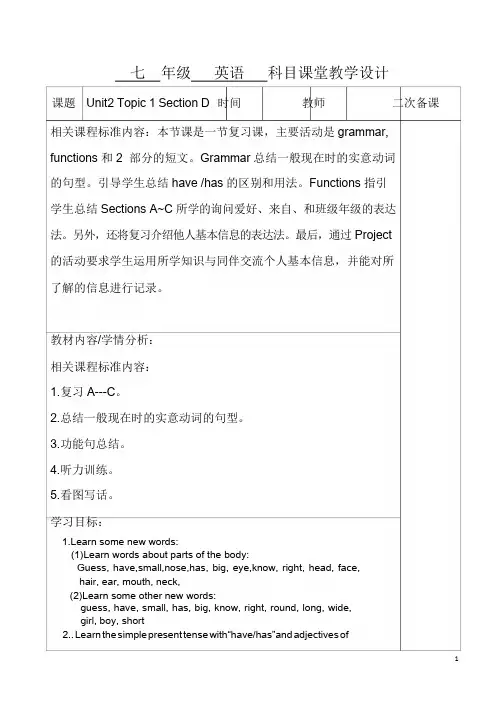
七年级英语科目课堂教学设计课题Unit2 Topic 1 Section D 时间教师二次备课相关课程标准内容:本节课是一节复习课,主要活动是grammar, functions 和2部分的短文。
Grammar总结一般现在时的实意动词的句型。
引导学生总结have /has的区别和用法。
Functions指引学生总结Sections A~C所学的询问爱好、来自、和班级年级的表达法。
另外,还将复习介绍他人基本信息的表达法。
最后,通过Project的活动要求学生运用所学知识与同伴交流个人基本信息,并能对所了解的信息进行记录。
教材内容/学情分析:相关课程标准内容:1.复习A---C。
2.总结一般现在时的实意动词的句型。
3.功能句总结。
4.听力训练。
5.看图写话。
学习目标:1.Learn some new words:(1)Learn words about parts of the body:Guess, have,small,nose,has, big, eye,know, right, head, face,hair, ear, mouth, neck,(2)Learn some other new words:guess, have, small, has, big, know, right, round, long, wide,girl, boy, short2.. Learn the simple present tense with“have/has”and adjectives ofdescription:(1)I have a big nose.(2)They have round faces.(3)She has long hair.(4)It has big ears.3. Learn how to describe people’s appearances.教学重点难点:引导学生正确使用一般现在时的实意动词的句型句型的表达方法。
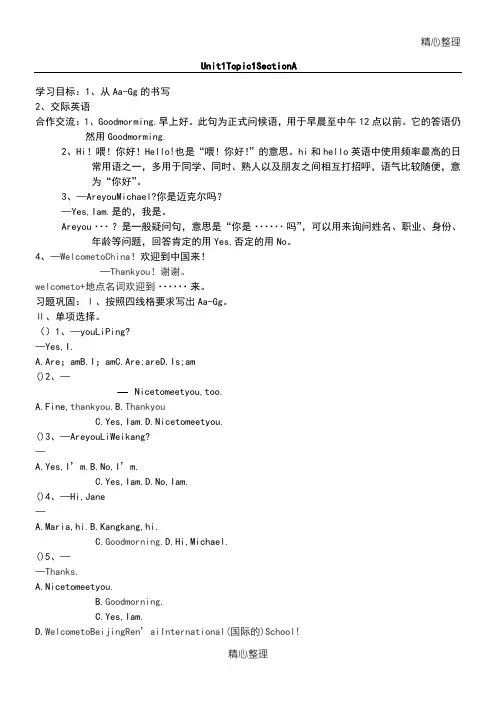
精心整理Unit1Topic1SectionA学习目标:1、从Aa-Gg的书写2、交际英语合作交流:1、Goodmorming.早上好。
此句为正式问候语,用于早晨至中午12点以前。
它的答语仍然用Goodmorming.2、Hi!喂!你好!Hello!也是“喂!你好!”的意思。
hi和hello英语中使用频率最高的日常用语之一,多用于同学、同时、熟人以及朋友之间相互打招呼,语气比较随便,意为“你好”。
3、—AreyouMichael?你是迈克尔吗?—Yes,Iam.是的,我是。
Areyou··年龄等问题,回答肯定的用Yes,4、—WelcometoChina!欢迎到中国来!—Thankyou!谢谢。
welcometo+地点名词欢迎到······来。
习题巩固:Ⅰ、按照四线格要求写出Aa-Gg。
Ⅱ、单项选择。
()1、—youLiPing?—Yes,I.A.Are;amB.I;()2、——A.Fine,thankyou.B.Thankyou()3、——A.Yes,I’m.()4、——A.Maria,hi.B.Kangkang,hi.C.Goodmorning.D.Hi,Michael.()5、——Thanks.A.Nicetomeetyou.B.Goodmorning.C.Yes,Iam.D.WelcometoBeijingRen’aiInternational(国际的)School!Ⅲ、从Ⅱ栏选出对应的答语。
ⅠⅡ()1.Goodmorning.A.Fine,thanks.()2.Hello!B.Nicetomeetyou,too.()3.Nicetomeetyou.C.No,Iamnot.()4.IamKangkang.AreyouMaria?D.Goodmorning.()5.Howareyou?E.Hi,Mr.Zhang.Unit1Topic1,SectionB 学习目标:1.字母的书写。
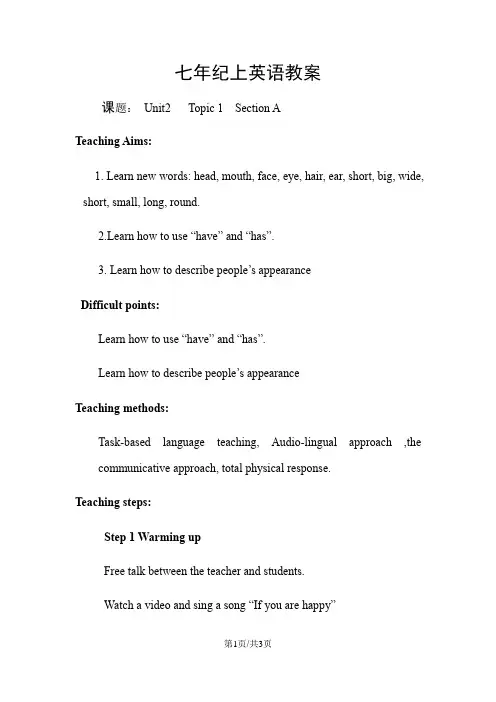
七年纪上英语教案课题:Unit2 Topic 1 Section ATeaching Aims:1. Learn new words: head, mouth, face, eye, hair, ear, short, big, wide, short, small, long, round.2.Learn how to use “have” and “has”.3. Learn how to describe people’s appearanceDifficult points:Learn how to use “have” and “has”.Learn how to describe people’s appearanceTeaching methods:Task-based language teaching, Audio-lingual approach ,the communicative approach, total physical response.Teaching steps:Step 1 Warming upFree talk between the teacher and students.Watch a video and sing a song “If you are happy”Lead-inFrom this video ,we can see many words of body, like hands, feet and eyes. Do you want to learn more about them?Step 2 Presentation1.Learn the new words(1) Learn the new words: listen to 2a carefully and follow ithead, mouth, face, eye, hair, ear, nose, big,wide, short, big, wide, short, small, long, round.Let’s play the game Bobby Says. In order to go over the name of body.(2)Learn the new words: long short, big ,small, wide, round.show pictures and learn adjectives.2 .Remember the new words by themselves. Pay attention to their spellings. Have a competition.Step 3 Consolidation(Ask a student to stand up)T: Who is she?Ss: She is...T: Look, everyone, what does she look like? She has long hair and a round face. What about you? What do you look like?Step 4 listen to the tape 2a and learn how to use have\hasFinish2b and check answersEnjoy an English song “she has, he has”Step 5: Listen and follow 1aListen to the tape and finish 1b.Finish 1c according to 1a and 1b.1. Ask students to follow to read2. Show to read in groups3. Act it out.Step 6: Practice. Ask the students to describe the people in the screen write it down Do reportPlay a guessing game。

仁爱版英语七年级上册_仁爱版七年级英语上册unit1教案Unit1 Making New FriendsTopic 1 Section D一学习目标1 复习26个字母2 复习所学问候交际语言①Hi! Hello!②Good morning. / Good afternoon. ③How are you? / Fine,thank you. ④How do you do? / How do you do?⑥I’m ...Are you ...? Yes, I am. ⑦See you later. See you. ⑧Good-bye. Bye-bye.3 了解并记住五个元音字母,并根据其读音把26个字母分类。
4 be动词的用法和与主语的缩写形式。
二学习重点 : 本课重点活动是1,2和4。
三学习难点: 26个字母的书写规则、读音和 B e( am, is are ) 动词的用法四学习过程(一) 复习导入按顺序和正确的格式书写26个字母补全下列对话1. A:Good morning,Mr.Chen2. A.How are you ? . B: ,3. A: Good afternoon4. A: Nice to see you . .5. A: Are you Jane ? B: Yes, .6 A: Hello, Mr. Lee7 teacher, B: Mr. Li , this is my mother.8A: How do you do? B: ?(二 )自学指导( 1 )本节课主要是复习以前所学内容,看课文第八页4a部分,语法聚焦,这部分主要学习Be动词的简单用法和其于主语的缩写形式。
要牢牢掌握。
( 2 ) 制作自己的名字卡片,指导在英语中人名字的表达和书写格式。
( 3 ) 5 个元音字母:Aa Ee Ii Oo Uu( 4 ) 掌握读音/ei/ /i:/ /ai/ / / /ju:/ 并试着把26个字母按读音进行分类(三) 问题导学1. 26 个字母可以分为几类?2. 同学们会把下列汉语翻译成英语吗?早上好_______________ 下午好 ____________________你好 __________________ 你身体好吗?______________________ 我身体好,谢谢,你呢?_______________________________________你是康康吗?__________ 是的,我是。

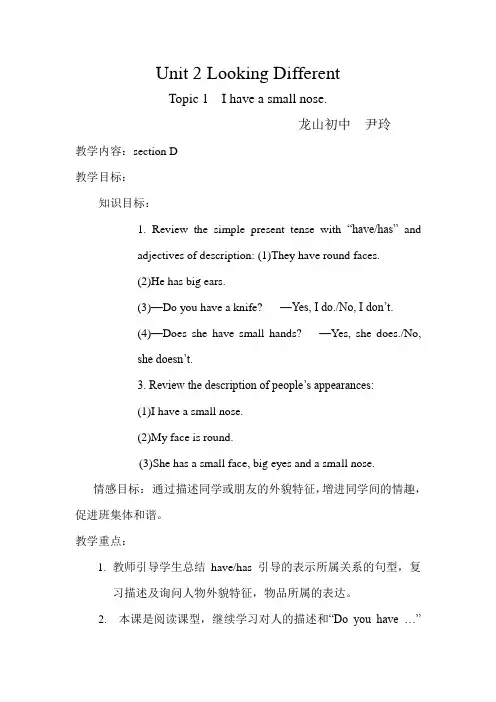
Unit 2 Looking DifferentTopic 1 I have a small nose.龙山初中尹玲教学内容:section D教学目标:知识目标:1. Review the simple present tense with “have/has”andadjectives of description: (1)They have round faces.(2)He has big ears.(3)—Do you have a knife? —Yes, I do./No, I don’t.(4)—Does she have small hands? —Yes, she does./No,she doesn’t.3. Review the description of people’s appearances:(1)I have a small nose.(2)My face is round.(3)She has a small face, big eyes and a small nose.情感目标:通过描述同学或朋友的外貌特征,增进同学间的情趣,促进班集体和谐。
教学重点:1.教师引导学生总结have/has 引导的表示所属关系的句型,复习描述及询问人物外貌特征,物品所属的表达。
2. 本课是阅读课型,继续学习对人的描述和“Do you have…”句型及其答语的使用。
教学难点:复习本话题有关描述任务外貌特征的表达,让学生在做中学习英语,关注学生多元智能的发展。
教学过程:Stage 1 getting students ready for learning师生间常规问候。
Stage 2 review wordsStep 1让学生听一首英文歌曲,总结本单元所学的新单词。
Now, let’s listen to an English song, and review the words about parts of the body. You should spell them one by one quickly. OK?Step 2 总结外貌特征和一些形容词的常用搭配,通过竞赛的方式鼓励学生说出更多的描述人物外貌特征的句子。

Unit2 Topic1 SectionA 优质课教案I.教学目标1. Learn some new words:(1) Learn words about parts of the body: nose, eye, head, face, hair, ear, mouth, neck.(2) Learn some other new words: guess, have, small, has, big, know, right, round, long, wide, girl, boy, short.2. Learn some useful sentences:(1) Oh, I know.(2) Yes, you’re right.3. Learn the simple present tense with “have/has” and adjectives of description:(1) I have a big nose.(2) They have round faces.(3) She has long hair.(4) It has big ears.4. Learn how to describe people’s appearances.Ⅱ.教具黑板、幻灯片课件Ⅲ.教学过程Step1借助体态语,帮助学生学习语言,并培养他们的观察能力。
1.(教师利用手势唱the Body Song,教师应按照从上到下、从局部到整体的手指人体部位,以便帮助学生记忆。
)Please listen and follow me, I will teach you a body song. Show me your hands and follow me. Please pay more attention to my fingers. I will touch the parts of my body. Let’s go!2.(利用2a的教学幻灯片,操练表示人体部位的名词。
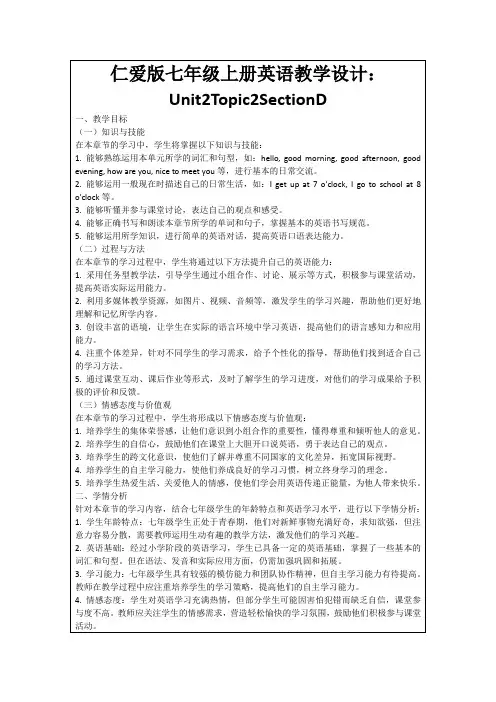
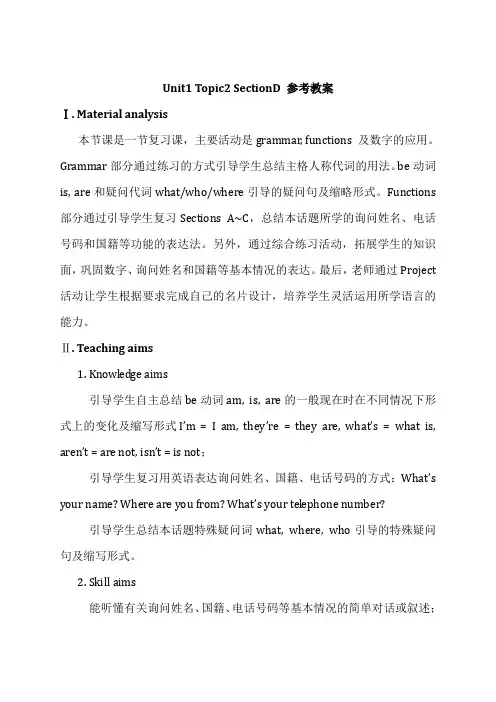
Unit1 Topic2 SectionD 参考教案Ⅰ. Material analysis本节课是一节复习课,主要活动是grammar, functions 及数字的应用。
Grammar部分通过练习的方式引导学生总结主格人称代词的用法。
be动词is, are和疑问代词what/who/where引导的疑问句及缩略形式。
Functions 部分通过引导学生复习Sections A~C,总结本话题所学的询问姓名、电话号码和国籍等功能的表达法。
另外,通过综合练习活动,拓展学生的知识面,巩固数字、询问姓名和国籍等基本情况的表达。
最后,老师通过Project 活动让学生根据要求完成自己的名片设计,培养学生灵活运用所学语言的能力。
Ⅱ. Teaching aims1. Knowledge aims引导学生自主总结be动词am, is, are的一般现在时在不同情况下形式上的变化及缩写形式I’m = I am, they’re = they are, what’s = what is, aren’t = are not, isn’t = is not;引导学生复习用英语表达询问姓名、国籍、电话号码的方式:What’s your name? Where are you from? What’s your telephone number?引导学生总结本话题特殊疑问词what, where, who引导的特殊疑问句及缩写形式。
2. Skill aims能听懂有关询问姓名、国籍、电话号码等基本情况的简单对话或叙述;能运用图文就表示询问姓名、国籍、电话号码等的基本情况的话题进行简单的交流;能正确地朗读对话,并能注意语音语调;能根据已学音标尝试拼读单词;能够初步了解元音字母a, e及辅音字母p, b, t, d, k, g的读音规则。
⒊ Emotional aims能够与同学积极合作,参与课堂活动,大胆实践,培养友好互助的精神;能有兴趣用所学的功能句进行口头对话;使学生乐于接触并了解异国文化。
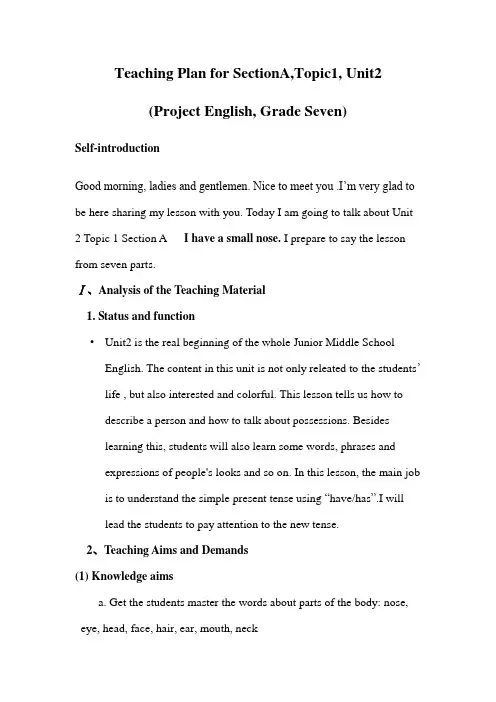
Teaching Plan for SectionA,Topic1, Unit2(Project English, Grade Seven)Self-introductionGood morning, ladies and gentlemen. Nice to meet you .I’m very glad to be here sharing my lesson with you. Today I am going to talk about Unit 2 Topic 1 Section A I have a small nose. I prepare to say the lesson from seven parts.Ⅰ、Analysis of the Teaching Material1. Status and function•Unit2 is the real beginning of the whole Junior Middle School English. The content in this unit is not only releated to the students’life , but also interested and colorful. This lesson tells us how todescribe a person and how to talk about possessions. Besideslearning this, students will also learn some words, phrases andexpressions of people's looks and so on. In this lesson, the main job is to understand the simple present tense using “have/has”.I willlead the students to pay attention to the new tense.2、Teaching Aims and Demands(1) Knowledge aimsa. Get the students master the words about parts of the body: nose, eye, head, face, hair, ear, mouth, neckb. Learn the simple present tense with “have/has” and understand some useful sentences:(1)I have a big nose.(2)They have round faces.(3)She has long hair.(4)It has big ears.c. Learn how to describe people’s appearances.(2) Skillful aimsa. Develop the students’ abilities of listening, speaking, reading and writing.b. Train the students’ abilities of communication.(3) Affective aimsa. Develop the students’ habits of paying close attention to the differences between Chinese culture and western culture.b. Strengthen the students’ conception of cooperation.c. Help the students feel the happiness of learning.3. Key points and difficult pointsAccording to the New English Curriculum Criterion and the students’ real situation, I choose the following materials as the key points and the difficult points of this class.(1)Key pointsa. Develop the st udents’ abilities of listening, speaking, reading and writing.b. Learn some information about people’s appearances.(2) Difficult pointsHow to use the simple present tense with “have/has”Part Ⅱ. Analysis of the StudentsThe students in my class are lovely and co-operative. Most of them are interested in English. They have learnt English for nearly three years. And they have learnt some basic skills of listening, speaking, reading and writing. But on one hand, they are eager to show themselves and want to have a try. On the other hand, in the daily life there are few chances for them to speak English and most of them are too shy to speak English in public or are afraid of making mistakes. So I will try my best to create a relaxing environment for them to practice using English.Part Ⅲ. Analysis of Teaching MethodIn this lesson I will mainly use Five Steps Method and Task-Based Language Teaching. I think if I want the students to improve their oral English, I must give them more chances to practice. That is “Learning by doing, learnin g by using”. In this case, by designing tasks according to the New English Curriculum Criterion, I will lead my students to study and cooperate with each other.Part Ⅳ. Analysis of Learning MethodThe main feature of the Task-Based Language Teaching is the students’ participation and creation. So I plan to enable the students to use “self-learning” and “co-operative learning” as their learning methods Thus, the students are required to do as follows:1. Be well prepared for the new lesson, look up some necessary information.2. In the class learning, the students should work actively and finish the tasks efficiently.3. The students should learn to work with others from their bottom of hearts.Part V. Analysis of Teaching ProceduresStep 1 Warming-up and Review(1)Show a table about Jane. Create a proper atmosphere for the new lesson . Then let the students answer the questions according to the table.T: What’s her name?S1: Her name is Jane.T: How old is she?S2: She is twelve.T: Where is she from?S3: She is from Canada.T: What class is she in?S4: She is in Class Four, Grade Seven.T: What’s her telephone number?S5: It’s (010)9267-6929.(2)Let the students look at a picture and review the words: eye, nose, mouth, ear, neck, head, hair.(3) In order to make the students remember the words quickly, I deside to play a game with them. And the name of the game is “Touch your body.”I say “Touch your nose”, the students touch it quickly. I’ll Praise the students with “well done. You are wonderful.Excellent” and so on . Reason: It is necessary for the students to review learned knowledge. Through this activity, the students can be cheered up, too.Step 2 Presentation1. Show some pictures and teach the phrases, such as, “a small nose, a wide mouth, long hair, big eyes, and so on.2. Let the students observe the picture, and try to say:She has long hair. He has a wide mouth.He has short hair. She has big eyes.3. Let the students read 1a after the tape and pay attention to the pronunciation and intonation. At the same time, let the students underline the words and phrases that they don’t understand.4. Read 1a again and complete 1b,check the answers. Encourage the students to get help from their group members.Reason: This step aims to make the students get the general idea of the article.Step 3 Consolidation1.Let the students look at the chart and discuss in groups. Showyourself. They will say: I have a small nose. He has a wide mouth.They have big eyes. She has long hair.2.I’ll let some students come to the front. Other st udents describehim/her using their words. They will feel excited.Reason: The step aims to make the students not only practicetheir speaking ability but also feel the happiness of learning. Step 4 Practice1.Work in groups. Show a picture and let the students writedown her appearance. Let them list as many sentences aspossible in groups.2.I’ll give the students some chances to shoe their passages infront of the students.Reason: Task-based language Teaching Method is used here to develop the students’ ab ility of writing and also their ability of their cooperation will be well trained.Step 5 HomeworkAfter class, I’ll let the Ss Write a passage about Jim’s appearance in the exercise book. I think homework is so important that the Ss should speak English as much as they can in class or after class. It is necessary for the Ss to do some exercises after class to consolidate the knowledge they learned.Blackboard Design:Reason: In this step, I’ll write the important words to help the students understand the present tense with have/has.Reflection about this lesson1. In the teaching process, we should encourage the students to join, observe, practice, think independently and cooperate. Change their thought from “I have to study.” to “I want to study.”2. As teachers, to make our English classrooms shine with vitality, we are laid with heavy burden, and we still have long way to go.Teaching Plan for SectionA,Topic1,Unit2(Project English, Grade Seven)。
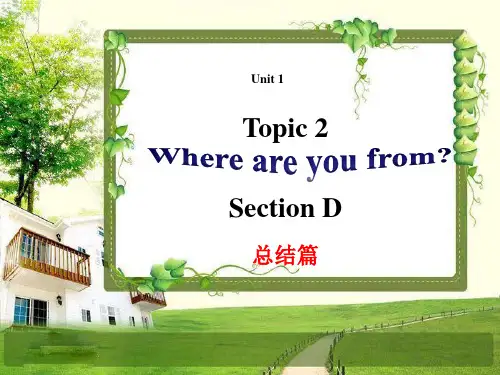
Unit1 Topic1 Section D The main activities are 1, 2 and 5. 本课重点活动是1, 2和5。
Ⅰ. Teaching aims and demands 教学目标1. (1)Review greetings:①Hi! Hello!②Good morning! / Good afternoon!③How are you? / I’m fine, thank you./Fine, thanks.④How do you do? / How do you do?⑤Nice to meet / see you. / Nice to meet/see you, too.⑥Wele to China!(2)Review the introduction:①—I’m… Are you…?—Yes, I am.②This is…(3)Review farewells:①—See you later.—See you.②—Goodbye.—Bye.2. Review the letters Aa-Zz.Ⅱ. Teaching aids 教具录音机/投影仪/字母卡片Ⅲ. Five-finger Teaching Plan 五指教学方案Step 1 Review 第一步复习(时间:10分钟) 1. (复习课堂用语。
)T: Good morning, class!Ss: Good morning, Mr. …/Miss…2. (复习问候语,老师先和学生对话做示X,后让学生自己表演。
巩固问候语的英文表达法,做到学以致用。
)T: Let’s review the greetings.(1)T: Hi! S1.(老师作挥手打招呼状。
)S1: Hello! Mr. …/Miss…T: Nice to meet/see you.(教师作握手状。
)S1: Nice to meet/see you, too.(2)T: Good morning, S2.(老师作挥手打招呼状。
Unit 1 Getting to Know YouTopic 1 Nice to meet you!Section AThe main activities are 1a, 2a and 3a. 本课重点活动是1a, 2a 和3a。
I .Teaching aims and demands 教学目标1.(1)Learn the letters Aa-Gg.(2)Learn some useful words and expressions:good, morning, welcome, to, China, thank, you, hello, I, am, I ' m, are, yes, no, not, nice, meet, too2. Talk about greetings and introductions:(1)—Good morning.— Good morning.(2)— Hi/Hello!—Hi/Hello!(3)— I ' m …Are you …?— Yes, I am./No, I ' m not. I ' m …(4)— Nice to meet you.-Nice to meet you, too.(5)—Welcome to China!—Thanks./Thank you.n . Teaching aids 教具录音机/字母卡片/投影仪/小黑板出.Five-finger Teaching Plan 五指教学方案Step 1 Introduction 第一步介绍(时间:6分钟)本节课是开篇,教师应向全体学生说明以下两点:1.学习英语的重要性。
2.学习英语的正确方法。
目的:激发学生学习英语的兴趣,提高学习效率。
Step 2 Presentation 第二步呈现(时间:14分钟)1.(运用真实情境,让学生学会如何与他人简单地打招呼。
Unit1 Topic2 SectionD优质课教案教学目标(一)、知识目标1、语言知识1)词汇掌握教材中的四会要求的单词和短语。
2)功能使学生能够询问对方姓名、国籍、电话号码,进行简单的对话交流:A、—What’s your name, please?—My name is Sally.B、—Where are you from?—I’m from Canada.C、—What’s your telephone number?—It’s 6807-5335.3)语法人称代词以及be动词的用法。
(二)、能力目标1、能听懂有关询问姓名、国籍、电话号码等基本情况的简单对话或叙述;2、能运用图文就表示询问姓名、国籍、电话号码等的基本情况的话题,进行简单的交流。
(三)、情感目标1、能体会到英语学习的乐趣。
2、有学好英语的信心,敢于用英语进行表达。
3、能够积极与同学合作参与课堂,大胆实践。
重点难点教学重点:1) 使学生掌握询问姓名、国籍、电话号码等的表达方法:A、—What’s your name, please?—My name is Sally.B、—Where are you from?—I’m from Canada.C、—What’s your telephone number?—It’s 6807-5335.2) 人称代词:I, you, they, we, she, he, it。
3) be动词am, is, are的一般现在时在不同情况下形式上的变化以及其缩写形式I’m=I am, what’s=what is, who’s=who is, where’s=where is aren’t=are not, isn’t=is not。
教学难点:正确使用be动词(am, is, are)及其缩写形式。
学情分析本节课的授课对象为农村中学七年级学生,刚刚从小学升入初中,学生的学习兴趣比较浓厚,但是基础参差不齐,有些学生小学阶段学校开设了英语课有一定的英语基础有些学生小学阶段有学过英语,但是不作为考察科目学了等于没有学;还有些学生小学阶段根本没有接触过英语的,连26个英文字母都不懂得。
Unit2 Topic1 Section A学习目标:1.复习who提问的句型。
2学习单词:head hair eye ear nose mouth face bigwide small long round short3.掌握have/has的用法。
学习重点和难点:1.have/has的用法。
2 .学习新单词。
学习过程:1.自主学习A:Who are you?B:I’m …A:Who is he/she?B:He/She is…2.合作交流,语言点导学(1)I have a small nose,but he has a big one.我长着一个小鼻子,但他长着一个大鼻子。
has是have的第三人称单数,当主语是she,he,it时用has;当主语是I,you,we,they时用have.如:Kangkang has big eyes.I have a small mouth.(2) She has long hair .她留着长发。
long hair 前没不定冠词a,因hair是不可数名词,它没单复数,不用a/an.学习巩固1.单项选择(1)He ____a big head.A.has B.have C.is(2)Mr.Lee has ____short hair, ____small nose and ____wide mouth.A.a;a;aB.a; the; /C./; a; a(3)His____are small, but his nose is big.A.hair B.eyeC.ears(4) ------ Are you Li Ping?------Yes,_________.A.he’sB.you’re rightC.I’m(5)This is my friend.____nose is big. A.He B.His C.She(6)-----Is he Kangkang?------____________.A.Yes, he is.B.Yes, he isn’t.C.No,he is.年级: 七年级科目:英语内容:Topic1SectionB学习目标:1 学习人体各部分名称,能够描述自己的外貌特征;2 熟练使用have/has陈述,疑问和回答。
七年级英语上册Unit2Topic1SectionD教案仁爱版/p/, /b/, /t/, /d/, /k/, /g/.2. Review the simple present tense with“have/has”.(1)He has small eyes.(2)They have round faces.(3)Do you have a pencil?Yes. I do./No, I don’t.(4)Does she have small eyes?Yes, she does./No, she doesn’t.3. (1)Reviewthe description of the people’s appearances.①I have a big nose.②My face is round.③He has short hair, a big nose and a wide mouth.(2)Review some useful expressions.①I know.②Yes, you’re right.③We are in the same school, but in different grades.Ⅱ. Teaching aids 教具单词卡片/录音机/图片Ⅲ. Five-finger Teaching Plan 五指教学方案Step 1 Review 第一步复习(时间:12分钟)1. (通过竞赛积分的形式利用单词卡片复习本单元的单词和主要句型。
)(1)(利用单词卡片进行集体认读单词活动,事先把单词进行归类,如身体部位类的、形容词类的等。
)Ss: noseSs: headSs: mouthSs: eye…(2)(小组活动。
把学习卡片打乱,展示中文意思的一面,以必答的形式让学生拼读单词,每组12个单词,答对1个1分。
)T: Let’s have words competition. I’ll show you the Chinese meanings of the words. You should spell them one by one quickly. Understand?Ss:Yes.T: OK. Let’s begin from Group One.(老师出示单词卡。
)S1: N-O-S-E, nose.T: Good. Next.S2: L-O-N-G, long.T: Good. Next one.S3: H-A-V-E, have.T: Next.S4: Er. ...T: Next one.S5: R-I-G-H-T, right.T: …(如果这个学生答不上来,由下一位学生来回答,结束后在表中填上分数。
)(3)(找两位学生,一位背朝黑板,另一位根据老师出示的单词卡片表演动作或用文具等进行提示,让自己的搭档说出句子,其中要有这个单词。
)T: Now. I’ll show you some words. One of you acts it out and the other makes a sentence. S6、S7, please come to the front.S6, You turn back.(教师出示has单词卡片)S7: (运用肢体语言表演)S6: I have a pencil.T: No. Try again.S6: He has a pencil.T: Good, “has”.(另请两位学生来表演,这时可多出示些单词卡片。
)S8: (表演) (出示long单词卡)S9: I have long hair.T: Good, “long”. Next.(再出示short)S9: He is short.S10: …S11: ……(在学生表演的过程中老师应多给予肯定评价,以此来活跃课堂气氛。
)(积分表可在课前画在黑板右方)Group 1 Group 2 Group 3 Group 4 …WordsSentences2. (师生互动问答,对Do you have…?句型进行复习。
)T: Do you have big ears?S11: Yes, I do.T: Do you have a big nose?S12: No, I don’t.T: Do you …?…3. (学生快速一个接着一个的进行Do you have …?句型的问答复习,老师可以先开个头。
)T: Do you have big ears?S13: No, I don’t. Do you have small ears?S14: Yes, I do. Do you have long hair?S15: Yes. I do. Do you … ?S16: ……4. (根据上一节课布置的作业,请一位学生描述一下自己母亲的外貌,然后鼓励学生主动参与描述。
)T: Very good. Now let’s describe your mothers. Zhong Bin, please.Zhong Bin: My mother has short hair, big ears and a smallmouth.T: Great. Another one?S17: ……Step 2 Presentation 第二步呈现(时间:5分钟)1. (利用事先准备的归类单词卡片,通过学生拼读方式来完成,注意突出/p/, /b/, /t/, /d/, /k/, /g/的音。
)T: OK. Boysand girls, attention please. Look at the word cards.Read and spell them.(老师依次出示pen, plane, apple三张卡片。
)Ss: Pen, P-E-N, pen.Ss: Plane, P-L-A-N-E, plane.Ss: Apple, A-P-P-L-E, apple.(板书单词与/p/,用彩色突出单词中的字母p,然后齐声朗读。
)(用已学音标,启发学生读这个单词)T: Now look at the blackboard and read them together.(以同样的方式学习/b/, /t/, /d/, /k/, /g/。
)/b/busbookbag/t/catphotobottle/d/doctorhanddumplings/k/deskchickencup/g/girlglasstiger2. (听1录音跟读,注意其发音,了解发音规律。
)T: Listen to 1 and repeat, pay more attention to the pronunciation. Then learn about the regularity of pronunciation.Step 3 Consolidation 第三步巩固(时间:10分钟)(再听录音,并让学生跟读,让学生为每个音标再找一例词来补充从而加深印象。
)T: Now listen to 1 and repeat.T: Who can find the same words about /p/?S1: Please.T: Good. Thank you.(教师用手势示意坐下。
)T: Who can find the same words about /b/?S2: box.T: Very good. Thank you.…Step 4 Practice 第四步练习(时间:8分钟)1. (1)(利用书中Kangkang的图片进行师生互动问答,复习有关描述外貌的句型。
)T: Who is this boy?Ss: He is Kangkang.T: Does he have a big head?Ss: Yes, he does.T: Does he have a big nose?Ss: No, he doesn’t.T:Does …Ss:……(再呈现一张Amy的图片进行类似上面的练习。
)T: Who is this girl?Ss: She is Amy.T:…Ss:……(2)(让学生根据图片,两人一组进行类似的口语练习。
)S1: Who’s this boy?S2: He is Kangkang.S1: …S2: ……(3)(根据班上同学的外貌特征让学生表演对话。
)S3: Hello, S4! Who is this girl?S4: Hello! She is Li Mei.S3: Does she have long hair?S4: Yes, she does.…(4)(让学生完整地描述老师的外貌。
)S5: This is my teacher, Mr. Chen. He has short hair. He has a small nose. … I like him.T: Well done. Thank you.2. (1)(听录音2,给“运动员”标上符号。
完成2。
)T: L ook at the picture in Part 2. We can see some boys. They are playing soccer. Now listen tothe tape and number the players in the order you hear. (2)(核对答案,再听1遍,请学生听写出句子,可利用暂停键。
)write down the whole sentence.3. (放3a和3b录音,学生齐读。
教师讲解,完成3a和3b。
)T: Listen and repeat. Then read together.Step 5 Project 第五步综合探究活动(时间:10分钟)1. (两人一组完成5,进一步练习介绍外貌的两种句型。
)T: Now work in pairs. Try to describe your parents or your friends to your partner. Thencomplete the chart. Then exchange roles.S1:My friend has …(S2填空,老师指导更正,然后换角色。
)S2:My friend has …2. (把学生分成6人一小组,每人说两句,整体描述两个人,这两个人须在这一小组里,哪一小组时间用的最少,而且描述的最完整则为获胜者。
)T: Let’s describe two of you. Everyone should say two sentences. Team One. Are you ready?Team 1: Yes.T: Begin.S1: I’m a boy. I’m fourteen years old.S2: I come from China. I’m a student.S3: I have a small face, a big nose and short hair. I have a good friend in my class.S4: Her name is Huang Yixin. She is fourteen, too.S5: …S6: ……3. (带领学生完成4。